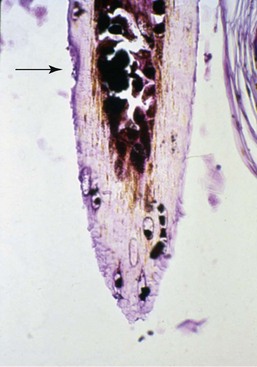Chapter 39 Endocrine diseases are among the many causes of symmetric alopecia in the dog. In certain situations the cutaneous manifestations of endocrine disease provide some of the most obvious clinical signs. However, the clinician must consider a number of common and uncommon disorders when approaching the dog with symmetric alopecia (Box 39-1). As with most dermatologic disorders, signalment, historical information, and physical findings are the starting points to a diagnosis, followed by performance of appropriate laboratory tests and the collection of a dermatologic minimum database. This chapter provides a concise and rational guide for achieving a diagnosis when confronted with a canine patient with bilaterally symmetric alopecia. More details about these specific conditions can be found in this section and in Section V of this textbook. A KOH prep also can be used to identify other conditions. For example, in dermatophyte-infected hairs fungal spores (microconidia) may be visible. Affected hairs have a damaged cuticle, are asymmetric, and are usually much wider than normal hairs. The presence of macromelanosomes along with a damaged hair cuticle may assist in the diagnosis of color-dilution alopecia (Figure 39-1); however, the definitive diagnosis is based on clinical signs and histopathologic evaluation. Interestingly, large melanosomes may be seen in color-dilute breeds such as the weimaraner, but the cuticle is not damaged; therefore these breeds do not exhibit color-dilution alopecia (with rare exceptions). Figure 39-1 Photomicrogram of a hair. The base of the hair is at the bottom. Note the damaged cuticle (arrow). Macromelanosomes can be seen within the hair; the melanosomes are large and clumped compared with the normal appearance (being much smaller, punctate, and distinct from each other).
Bilaterally Symmetric Alopecia in Dogs
Pruritic Alopecia

< div class='tao-gold-member'>
Bilaterally Symmetric Alopecia in Dogs
Only gold members can continue reading. Log In or Register to continue

Full access? Get Clinical Tree


